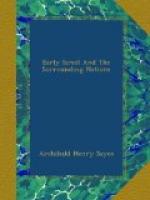This was the last trial demanded from the justified Egyptian, and it was a hard one for the rich and noble who had done no peasants’ work in this present life. Accordingly, small images of labourers were buried with the dead, and it was supposed that their “doubles” or shadows would assist him in his labours. The supposition rested on a theory which ascribed to all things, whether animate or inanimate, a double or reflection which corresponded to the thing itself in every particular. It was like a shadow, except that it was invisible to mortal eyes, and did not perish with the object which had projected it.
The “double” was called ka, and the ka of a man was his exact representation in the other world, a spiritual representation, it is true, but nevertheless one which had the same feelings, the same needs, and the same moral nature as himself. It thus differed from the ba or “soul,” which flew away to the gods on the dissolution of the body. It was, in fact, the Personality of the man.
From the outset the Pharaonic Egyptians were a nation of readers and writers. Nothing is more astonishing than the way in which the simplest articles of daily use are covered with inscriptions. Even the rocks on the river-bank are scribbled over by the generations who once passed beside them. Already in the time of Menes the hieroglyphic system of writing was fully developed, and before the end of the Third dynasty a “hieratic” or running hand had been formed out of it. The more cumbrous and picturesque hieroglyphics were reserved for engraving on wood or stone or metal, or for the sacred texts; the ordinary book was written in hieratic. The papyrus which grew in the marshes of the Delta was the writing material, and in spite of its apparently fragile character, it has been found to last as long as paper. When its use was at last discontinued in the tenth century of our era, the cultivation of the papyrus ceased also, and it became extinct in its ancient home. Tradition, however, asserted that leather had been employed by the scribe before papyrus, and in the time of Pepi of the Sixth dynasty a description of the plan of the temple of Dendera was discovered inscribed on parchment. Even in later ages leather was sometimes employed.
Egyptian literature covered a wide field. Two of the oldest books that have come down to us are the wise sayings of Qaqemna and Ptah-hotep, the first of whom lived under the Third, the second under the Fifth dynasty. They are moral treatises like the Proverbs of Solomon or the Discourses of Confucius. Ptah-hotep already laments that men were not as they had been. He had reached the age of a hundred and ten years, and had fallen upon degenerate days. Perhaps he was right, for it would seem that the examination system had already been introduced for the disposal of official posts. Ptah-hotep’s style, too, is involved and elaborate; he writes for a blase circle of readers who can no longer appreciate simplicity.




